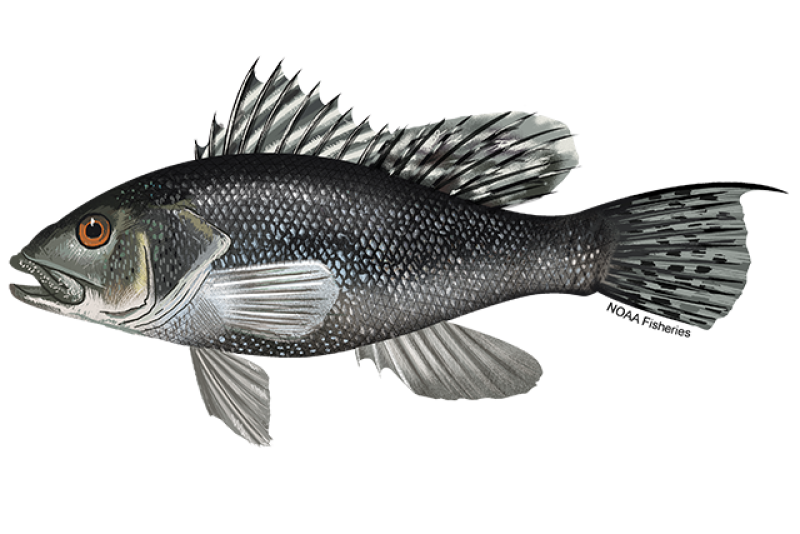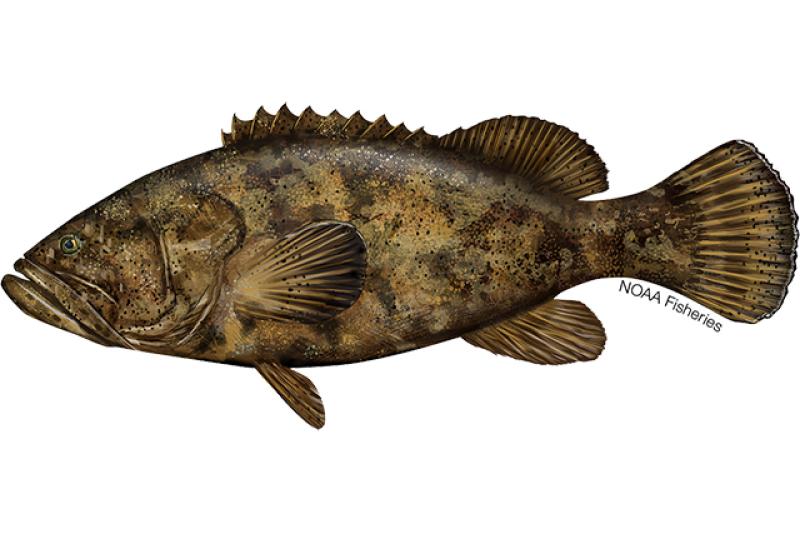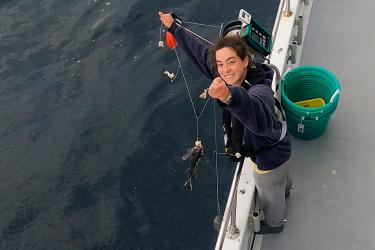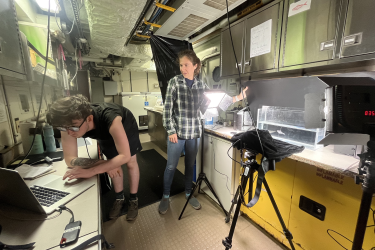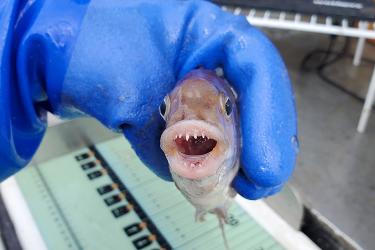Black Sea Bass
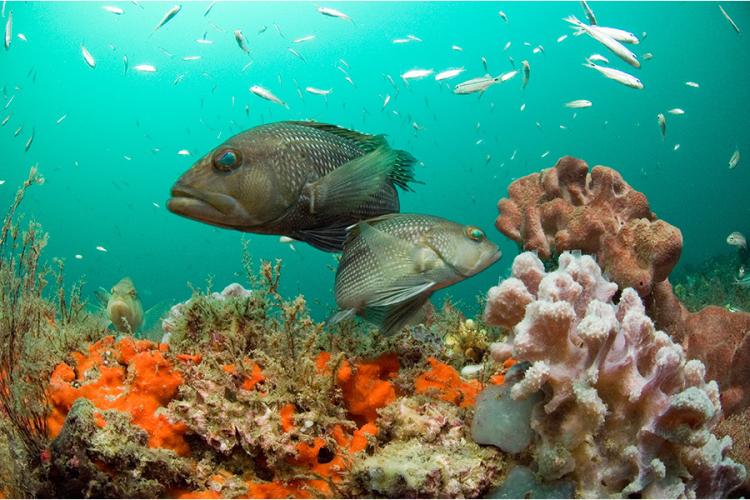 Black sea bass. Credit: NOAA Fisheries
Black sea bass. Credit: NOAA Fisheries
Black sea bass. Credit: NOAA Fisheries
About the Species
 Black sea bass. Credit: NOAA Fisheries
Black sea bass. Credit: NOAA Fisheries
Black sea bass. Credit: NOAA Fisheries
The black sea bass fishery in the U.S. operates from Maine to Florida. Black sea bass are found in association with structured habitats. They migrate offshore and south in the fall, returning north and inshore to coastal areas and bays in spring. The black sea bass fishery predominantly uses trawls or rod and reel, but other gear includes longline, handline, pot, trap, gillnet, spear, and dredge. The market for black sea bass is for human consumption. U.S. wild-caught black sea bass is a smart seafood choice because it is sustainably managed and responsibly harvested under U.S. regulations. Implementing regulations are found at 50 CFR part 648 subpart I.

Population
The stocks are not overfished.

Fishing Rate
Not subject to overfishing.

Habitat Impact
Fishing gears used to harvest black sea bass have minimal impacts on habitat.

Bycatch
Regulations are in place to minimize bycatch.
Population Status
- There are two stocks of black sea bass: Mid-Atlantic and South Atlantic stocks. According to the most recent stock assessments:
- The Mid-Atlantic stock is not overfished and is not subject to overfishing (2021 stock assessment). Summary stock assessment information can be found on Stock SMART.
- The South Atlantic stock is not overfished (2018 stock assessment) and is not subject to overfishing based on 2021 catch data. Summary stock assessment information can be found on Stock SMART.
- Although both stocks of black sea bass have been assessed, the biology of this species is not well known and data are lacking, resulting in stock assessments that have a high degree of uncertainty.
- In the Mid-Atlantic, scientists at NOAA’s Northeast Fisheries Science Center conduct bottom trawl surveys to estimate the abundance of black sea bass and other species.
- In the South Atlantic, scientists, managers, and stakeholders assess the status of these stocks through the Southeast Data, Assessment, and Review (SEDAR) process.
Appearance
- Black sea bass are usually black, but smaller ones are more of a dusky brown.
- The belly is slightly paler than the sides.
- Fins are dark with dusky spots.
- The dorsal fin is marked with a series of white spots and bands.
- During spawning, dominant males turn bright blue and have a blue hump on their heads.
Biology
- Black sea bass grow slowly, up to 2 feet and 9 pounds.
- They are able to reproduce when they reach 1 to 3 years old.
- They are protogynous hermaphrodites—most black sea bass start out as females, and as they mature and grow they become males. Researchers aren’t sure why this happens, but one hypothesis suggests the relative scarcity of males in a spawning group may be the stimulus for a female to switch sex.
- Black sea bass spawn in coastal areas from January through July.
- Males gather a group of females to mate with and aggressively defend their territory.
- Depending on their size, females can produce between 30,000 and 500,000 eggs in a spawning season.
- Females can live up to 8 years; males live up to 12.
- Black sea bass eat whatever prey is available, but they especially like crabs, shrimp, worms, small fish, and clams.
- Little skate, spiny dogfish, monkfish, spotted hake, and summer flounder all feed on black sea bass.
Where They Live
Range
- Along the U.S. East Coast from Cape Cod to the Gulf of America (formerly Gulf of Mexico).
Habitat
- Black sea bass prefer structured habitats such as reefs, wrecks, or oyster beds in temperate and subtropical waters.
- In the Mid-Atlantic (north of Cape Hatteras, North Carolina), they migrate seasonally as water temperature changes.
- They generally migrate to inshore coastal areas and bays in the spring and offshore in the fall.
- In the South Atlantic, black sea bass do not tend to migrate as far.
Fishery Management
- NOAA Fisheries, the Mid-Atlantic Fishery Management Council, and the Atlantic States Marine Fisheries Commission cooperatively manage the black sea bass fishery north of Cape Hatteras, North Carolina.
- Managed under the Summer Flounder, Scup, and Black Sea Bass Fishery Management Plan:
- Annual catch limit divided between the commercial and recreational fisheries.
- The commercial catch limit is further divided among the states based on historical harvests.
- Specific management measures for the commercial fishery include:
- Minimum size limits.
- Minimum mesh requirements for trawls.
- A moratorium on entry into the fishery.
- Closed seasons.
- NOAA Fisheries and the South Atlantic Fishery Management Council manage the black sea bass fishery south of Cape Hatteras, North Carolina.
- Managed under the South Atlantic Snapper Grouper Fishery Management Plan:
- Commercial fishermen must have a permit to harvest black sea bass.
- Annual catch limits, commercial trip limits, and recreational bag and possession limits.
- Sale and purchase restrictions applicable after a commercial quota closure.
- Minimum size limit.
- Accountability measures in place to ensure overfishing does not occur, or to correct for overages if catch limit is exceeded.
- Seasonal area closures for the commercial black sea bass component of the snapper-grouper fishery.
- Trawling has been banned in the South Atlantic since 1989 to prevent impacts to habitat.
- Gear restrictions for fish pots:
- Commercial fishermen must have a pot endorsement to use a black sea bass pot to harvest black sea bass.
- Minimum mesh size to reduce catch of undersized black sea bass.
- Pots must have escape vents and escape panels with degradable fasteners to prevent bycatch.
- Limit on the number of pots per trip.
- Pots must be brought back to shore at the end of each trip to reduce bycatch and impacts to habitat and protected species.
- Pots are only allowed north of Cape Canaveral, Florida, to prevent adverse impacts on live-bottom habitat.
- Spatial and temporal closures to minimize entanglement risk for endangered North Atlantic Right Whales. //
Harvest
- Commercial fishery:Gear types, habitat impacts, and bycatch:
- In 2023, commercial landings of black sea bass totaled 4.7 million pounds, and were valued at $13 million, according to the NOAA Fisheries commercial fishing landings database.
- In the Mid-Atlantic, commercial fishermen mainly use hook-and-line gear, pots, and otter trawls to catch black sea bass. Fisheries for black sea bass change seasonally with the species’ migrations.
- Of the gear utilized within the snapper grouper fishery, only the black sea bass pot is considered to pose an entanglement risk to marine mammals.
- When the fish are inshore, commercial fishermen catch them primarily with fish pots (both baited and unbaited) and handlines.
- Once the fish move offshore in the winter, they’re caught in the trawl fishery that primarily targets summer flounder, scup, and longfin squid.
- In the South Atlantic, fishermen use pots and sometimes handlines.
- Fish bycatch in the pot fishery is minor because the gear is often not baited (black sea bass are drawn the structure and enter the pots without bait), and the pot mesh size is regulated to select fish at or above the minimum size limit.
- Recreational fishery
- Recreational fishermen use handlines to catch black sea bass.
- In 2023, recreational anglers landed 8.2 million pounds of black sea bass, according to the NOAA Fisheries recreational fishing landings database.
- In the Mid-Atlantic:
- There are size and bag limits, and seasonal measures, established for federal waters as well as by each state, to ensure that the recreational harvest limit is not exceeded.
- The recreational fishery is evaluated after the season, and management measures (bag, size, and/or season) are adjusted as needed in the following year.
- In the South Atlantic:
- There are size limits, fishing season, and daily and yearly catch limits, established for federal waters as well as by each state.
- There is a limit on annual recreational harvest, and recreational harvest is prohibited when the limit is met. If annual catch exceeds the limit, the overage is taken off the following year’s limit.
Scientific Classification
- Along the U.S. East Coast from Cape Cod to the Gulf of America (formerly Gulf of Mexico).
- Black sea bass prefer structured habitats such as reefs, wrecks, or oyster beds in temperate and subtropical waters.
- In the Mid-Atlantic (north of Cape Hatteras, North Carolina), they migrate seasonally as water temperature changes.
- They generally migrate to inshore coastal areas and bays in the spring and offshore in the fall.
- In the South Atlantic, black sea bass do not tend to migrate as far.
Fishery Management
- NOAA Fisheries, the Mid-Atlantic Fishery Management Council, and the Atlantic States Marine Fisheries Commission cooperatively manage the black sea bass fishery north of Cape Hatteras, North Carolina.
- Managed under the Summer Flounder, Scup, and Black Sea Bass Fishery Management Plan:
- Annual catch limit divided between the commercial and recreational fisheries.
- The commercial catch limit is further divided among the states based on historical harvests.
- Specific management measures for the commercial fishery include:
- Minimum size limits.
- Minimum mesh requirements for trawls.
- A moratorium on entry into the fishery.
- Closed seasons.
- NOAA Fisheries and the South Atlantic Fishery Management Council manage the black sea bass fishery south of Cape Hatteras, North Carolina.
- Managed under the South Atlantic Snapper Grouper Fishery Management Plan:
- Commercial fishermen must have a permit to harvest black sea bass.
- Annual catch limits, commercial trip limits, and recreational bag and possession limits.
- Sale and purchase restrictions applicable after a commercial quota closure.
- Minimum size limit.
- Accountability measures in place to ensure overfishing does not occur, or to correct for overages if catch limit is exceeded.
- Seasonal area closures for the commercial black sea bass component of the snapper-grouper fishery.
- Trawling has been banned in the South Atlantic since 1989 to prevent impacts to habitat.
- Gear restrictions for fish pots:
- Commercial fishermen must have a pot endorsement to use a black sea bass pot to harvest black sea bass.
- Minimum mesh size to reduce catch of undersized black sea bass.
- Pots must have escape vents and escape panels with degradable fasteners to prevent bycatch.
- Limit on the number of pots per trip.
- Pots must be brought back to shore at the end of each trip to reduce bycatch and impacts to habitat and protected species.
- Pots are only allowed north of Cape Canaveral, Florida, to prevent adverse impacts on live-bottom habitat.
- Spatial and temporal closures to minimize entanglement risk for endangered North Atlantic Right Whales. //
Harvest
- Commercial fishery:Gear types, habitat impacts, and bycatch:
- In 2023, commercial landings of black sea bass totaled 4.7 million pounds, and were valued at $13 million, according to the NOAA Fisheries commercial fishing landings database.
- In the Mid-Atlantic, commercial fishermen mainly use hook-and-line gear, pots, and otter trawls to catch black sea bass. Fisheries for black sea bass change seasonally with the species’ migrations.
- Of the gear utilized within the snapper grouper fishery, only the black sea bass pot is considered to pose an entanglement risk to marine mammals.
- When the fish are inshore, commercial fishermen catch them primarily with fish pots (both baited and unbaited) and handlines.
- Once the fish move offshore in the winter, they’re caught in the trawl fishery that primarily targets summer flounder, scup, and longfin squid.
- In the South Atlantic, fishermen use pots and sometimes handlines.
- Fish bycatch in the pot fishery is minor because the gear is often not baited (black sea bass are drawn the structure and enter the pots without bait), and the pot mesh size is regulated to select fish at or above the minimum size limit.
- Recreational fishery
- Recreational fishermen use handlines to catch black sea bass.
- In 2023, recreational anglers landed 8.2 million pounds of black sea bass, according to the NOAA Fisheries recreational fishing landings database.
- In the Mid-Atlantic:
- There are size and bag limits, and seasonal measures, established for federal waters as well as by each state, to ensure that the recreational harvest limit is not exceeded.
- The recreational fishery is evaluated after the season, and management measures (bag, size, and/or season) are adjusted as needed in the following year.
- In the South Atlantic:
- There are size limits, fishing season, and daily and yearly catch limits, established for federal waters as well as by each state.
- There is a limit on annual recreational harvest, and recreational harvest is prohibited when the limit is met. If annual catch exceeds the limit, the overage is taken off the following year’s limit.
Scientific Classification
| Kingdom | Animalia | Phylum | Chordata | Class | Actinopterygii | Order | Perciformes | Family | Serranidae | Genus | Centropristis | Species | striata |
|---|
Last updated by NOAA Fisheries on 07/02/2025
Featured News
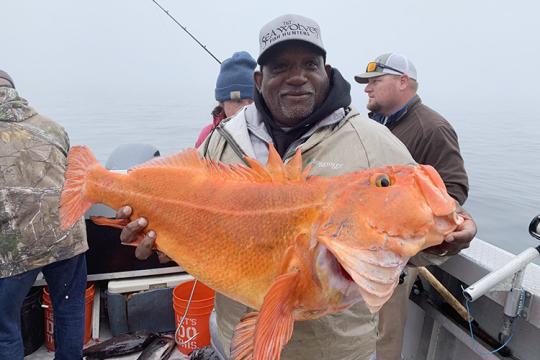

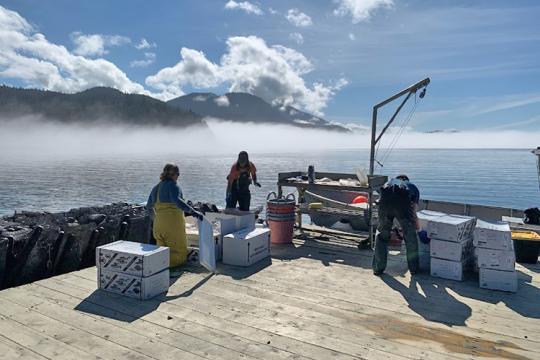 Monitoring work at Salty Lady Seafood farm. Credit: NOAA Fisheries.
Monitoring work at Salty Lady Seafood farm. Credit: NOAA Fisheries.
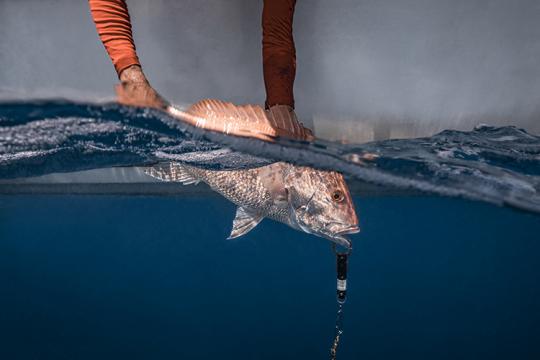
Recreational Fishing Regulations
Possession Limits and Fish Size Requirements
In 2025, we approved conservation equivalency for the black sea bass recreational fishery. Under conservation equivalency, states or regions develop minimum sizes, possession limits, and fishing seasons that will achieve the necessary level of conservation. Please check with your local state agency for any state or regional measures and requirements that may apply.
Reporting A Recreational Catch
Catch Reporting and Vessel Trip Reports (VTR)
For all charter/party permit holders, VTRs must be maintained on board the vessel and submitted to NOAA Fisheries for all fishing trips, regardless of species retained. Instructions for completing the VTR can be found online on our reporting page.
eVTRs
Charter/Party vessel permit owners and operators with a federal charter/party (for-hire) permit to fish for black sea bass (and other Mid-Atlantic species) must submit the required VTR by electronic means through a software application approved by NOAA Fisheries. These electronic log VTRs must be submitted within 48 hours after entering port at the conclusion of a trip. More information of the eVTR requirements and help with electronic reporting can be found online on our reporting page.
Other Reporting Information
The recreational (charter/party) black sea bass fishery does not have any Interactive Voice Response (IVR), Vessel Monitoring System (VMS), or specific observer requirements. However, all federally permitted vessels are obligated to carry an observer if randomly selected by the National Observer Program.
Reporting is not required for the private recreational fishery, but the Marine Recreational Information Program (MRIP) is a system of voluntary coordinated data collection programs designed to estimate recreational catch and effort.
Last updated by NOAA Fisheries on 07/02/2025
Commercial Fishing Regulations
Possession and Size Requirements
The minimum commercial size limit for black sea bass is 11 inches in total length (Note: Filament/tail extension is NOT included in total length measurement).
There are no federal possession limit requirements in the commercial black sea bass fishery unless using certain gear types (see below).
Please check with your state agency for any state or regional measures and requirements that may apply.
Current Black Sea Bass Specifications (January 1-December 31, 2025)
| Overfishing Limit (OFL) | 17.01 million lb |
|---|---|
| Acceptable Biological Catch (ABC) | 16.66 million lb |
| Commercial Annual Catch Limit (ACL) | 7.50 million lb |
| Commercial Annual Catch Target (ACT) | 7.50 million lb |
| Commercial Quota | 6.00 million lb |
| Recreational ACL and ACT | 9.16 million lb |
| Recreational Harvest Limit (RHL) | 6.27 million lb |
Reporting A Commercial Catch
Catch Reporting and Vessel Trip Reports (eVTR)
Owners/operators of vessels holding a federal black sea bass permit must submit vessel trip reports electronically using approved electronic vessel trip report software. eVTRs must be complete to the extent possible prior to entering port and submitted within 48 hours of offloading fish. For more information about trip reporting, and to see a list of approved electronic vessel trip report software applications, please visit the Greater Atlantic Region vessel trip reporting page.
Other Reporting Information
The commercial black sea bass fishery does not have any Interactive Voice Response (IVR), Vessel Monitoring System (VMS), or specific observer requirements. However, all federally permitted vessels are obligated to carry an observer if randomly selected by the National Observer Program.
Commercial Gear Information
Otter trawlers – Vessels fishing under a black sea bass moratorium permit must have a minimum mesh size of 4.5-in diamond mesh applied throughout the codend for at least 75 continuous meshes forward of the end of the net. For codends with less than 75 meshes, the entire net must have a minimum mesh size of 4.5-in diamond mesh throughout. Black sea bass must be stored so as to be readily available for inspection in a standard 100 lb tote.
Vessels with a black sea bass moratorium permit that are not fishing in compliance with the above mesh requirements may retain no more than 500 lb from January 1 through March 31, and no more than 100 lb from April 1 through December 31.
Roller gear – A fishing vessel shall not use roller rig trawl gear with rollers greater than 18 inches in diameter.
Pots and traps – Black sea bass pots must have ghost panels (measuring 3 in by 6 in), degradable hinges, two escape vents in the parlor, and identification as follows:
- Degradable Hinges made with
- Untreated hemp, jute, or cotton string of 3/16 in diameter or smaller; or
- Magnesium alloy, pop-up devises or similar magnesium alloy fasteners; or
- Ungalvanized or uncoated iron wire 0.094 in diameter or smaller.
- Escape Vents
- Rectangular vents measuring 1 3/8 in by 5 ¾ in; or
- Circular vents measuring 2.5 in in diameter; or
- Square vents with sides of 2 in, inside measure; or
- Spaces of at least 1 3/8 in between two sets of wooden laths.
- Identification
- Marked with state registration number; and/or
- Marked with U.S. Coast Guard documentation number.
Last updated by NOAA Fisheries on 07/02/2025
Seafood Facts

Is Black Sea Bass Sustainable?
U.S. wild-caught black sea bass is a smart seafood choice because it is sustainably managed and responsibly harvested under U.S. regulations.
Availability
Generally year-round, but varies by state.
Source
U.S. wild-caught from Massachusetts to the west coast of Florida. The United States is the only source for this species.
Taste
Mild, fresh, somewhat delicate flavor.
Texture
Tender but firm.
Color
Uncooked meat should be sparkling white and translucent. The meat is snow white when cooked.
Health Benefits
Black sea bass is a good low-fat source of protein and magnesium.
Nutrition Facts
Servings: 1; Serving Weight: 100 g (raw); Calories: 97; Protein: 18.43 g; Total Fat: 2 g; Total Saturated Fatty Acids: 0.511 g; Carbohydrate: 0 g; Total Sugars: 0 g; Total Dietary Fiber: 0 g; Cholesterol: 41 mg; Selenium: 36.5 mcg; Sodium: 68 mgMore Information
Black Sea Bass Recipes
Need cooking inspiration to incorporate black sea bass into your rotation? Browse these recipes for grilled black sea bass, broiled black sea bass, and more!

Last updated by NOAA Fisheries on 07/02/2025
Seafood News
 Celebrate Culinary Arts Month with a sustainable seafood recipe for every month of the year.
Celebrate Culinary Arts Month with a sustainable seafood recipe for every month of the year.
What Your Birth Month Says About Your Next Seafood Recipe
 Fresh-caught taʻape on ice. Credit: Conservation International Hawaiʻi.
Fresh-caught taʻape on ice. Credit: Conservation International Hawaiʻi.
Reducing Waste and Feeding Communities in Hawaiʻi with a Whole Fish Approach
 Chef Tyler Hadfield’s Curried Skate Wings with Tomato-Masala Chutney
Chef Tyler Hadfield’s Curried Skate Wings with Tomato-Masala Chutney
Ring In the New Year With These Crowd-Favorite Seafood Recipes
 NOAA Fisheries, in collaboration with Blue Ocean Mariculture, is conducting a multi-year pilot study to evaluate observational methods and tools for studying Hawaiian monk seal behavior. Courtesy of Blue Ocean Mariculture
NOAA Fisheries, in collaboration with Blue Ocean Mariculture, is conducting a multi-year pilot study to evaluate observational methods and tools for studying Hawaiian monk seal behavior. Courtesy of Blue Ocean Mariculture
AI Meets Aquaculture to Study Hawaiian Monk Seal Interactions With Net Pens
Management Overview
The black sea bass fishery is managed in state and federal waters by the Mid-Atlantic Fishery Management Council, in conjunction with the Atlantic States Marine Fisheries Commission. NOAA Fisheries serves as the implementing body for rules and regulations within the fishery.
The fishery is managed using minimum size, season, and a bag limit for the recreational fishery; and an annual coast-wide quota, size limit, and gear restrictions for the commercial fishery.
The fishing year runs from January 1 through December 31, and there are no specified management areas for the fishery; with NOAA Fisheries Greater Atlantic Region jurisdiction covering black sea bass from Maine to Cape Hatteras, North Carolina (35° 15.3’ N latitude).
Control Date for the Black Sea Bass Fishery: June 5, 2001
Specifications/Quotas
The Black Sea Bass Fishery Management Plan (FMP) requires the specification of catch and harvest limits for up to three years at a time.
Inseason Actions
If the coast-wide commercial black sea bass quota is fully harvested, then the commercial black sea bass fishery will be closed.
Accountability Measures (AM)
Commercial AM
Any overages of the annual coast-wide quota will be deducted from the quota allocation for the following year in the final rule that establishes the annual quota.
Recreational AM
The recreational sector ACL will be evaluated based on a 3-year moving average comparison of total catch (landings and dead discards). Both landings and dead discards will be evaluated in determining if the 3-year average recreational ACL has been exceeded. If available data indicate that the recreational sector ACL has been exceeded, the total catch exceeds the ABC, or the total catch exceeds the OFL, then a system of accountability measures will be used that are based on a combination of how high the overage is and what condition the stock is in. In other words, the status of the stock determines what type of management response would be implemented, including adjustment of management measures, scaled payback of overage, or pound-for-pound overage payback. These adjustments will be made in the following fishing year, or as soon as possible, as a single-year adjustment.
Regulatory History
- 1996 – Black Bass Fishery Management Plan (FMP) is incorporated into the Summer Flounder FMP (through Amendment 9); established black sea bass management measures including commercial quotas, recreational harvest limits, size limits, gear restrictions, permits, and reporting requirements.
- 1997 – Amendment 10 modified commercial minimum mesh requirements, continued commercial vessel moratorium, and prohibited transfer of fish at sea.
- 1998 – Amendment 11 modified certain provisions related to vessel replacement and upgrading, permit history transfer, splitting, and permit renewal regulations.
- 2001 – Framework 1 established quota set-aside for research.
- 2003 – Amendment 13 revised the black sea bass commercial quota system.
- 2004 – Framework 5 established multi-year specification setting of quota.
- 2007 – Framework 7 built flexibility into the process to define and update status determination criteria for species.
- 2007 – Amendment 16 standardized bycatch reporting methodology.
- 2009 – Mid-Atlantic black sea bass is considered rebuilt.
- 2011 – Amendment 15 established annual catch limits and accountability measures.
- 2014 – Amendment 19 changed recreational accountability measures.
- 2015 – Amendment 17 implemented Standardized Bycatch Reporting Methodology.
- 2015 – Framework 8 changed the start date of the recreational fishing season from May 19 to May 15.
- 2015 – Amendment 18 eliminated the requirement for vessel owners to submit "did not fish" reports for months or weeks when their vessel was not fishing. Removed some of the restrictions for upgrading vessels listed on Federal fishing permits
- 2017 – Amendment 20 implemented management measures to prevent the development of new, and the expansion of existing, commercial fisheries on certain forage species in the Mid-Atlantic. Framework 10 implemented a requirement for vessels that hold party/charter permits for Council-managed species to submit vessel trip reports electronically (eVTRs) while on a trip carrying passengers for hire.
- 2018 – Framework 11 established a process for setting constant multi-year Acceptable Biological Catch (ABCs) and clarified the process for setting ABCs for each of the four types of ABC control rules. Framework 13 modified the accountability measures required for overages not caused by directed landings (i.e., discards).
- 2019 – Framework 14 gave the Council the option to waive the federal recreational measures in favor of state measures through conservation equivalency; implemented a transit zone in Block Island Sound; and allowed for the use of a maximum size limit in the recreational fishery.
- 2020 – Framework 15 established a requirement for commercial vessels with federal permits for all species managed by the Mid-Atlantic and New England Councils to submit vessel trip reports electronically within 48 hours after entering port at the conclusion of a trip. Framework 16 modified the Council’s ABC control rule and risk policy. The revised risk policy is intended to reduce the probability of overfishing as stock size falls below the target biomass while allowing for increased risk and greater economic benefit under higher stock biomass conditions.
- 2022 – Amendment 22 revised the commercial and recreational sector allocations for the species. Framework 17 established a new process for setting recreational bag, size, and season limits (i.e., recreational measures). This action also modified the recreational accountability measures.
- 2024 – Amendment 23 modified the allocations of the commercial quota among the states of Maine through North Carolina and modified the commercial in-season closure regulations. NOAA Fisheries disapproved the portion of the amendment which would have added the state allocations to the Council’s FMP. However, the revised allocations were implemented through the Commission’s FMP.
More Information
Last updated by NOAA Fisheries on 07/02/2025
Science Overview
NOAA Fisheries conducts various research activities on the biology, behavior, and population health of black sea bass. The results of this research are used to inform management decisions for this species.
For detailed information about stock status, management, assessments, and resource trends, you can search for black sea bass, and any other species of interest, using NOAA’s StockSMART web tool.
Researching Black Sea Bass in the Southeast
Using data from the Southeast Reef Fish Survey, NOAA Fisheries researchers and partners identified the spawning season and several spawning locations for black sea bass along the southeastern United States. Their research is described in the open access journal PLoS ONE, and was also adapted for schools in The Science Journal for Kids.
Last updated by NOAA Fisheries on 07/02/2025
Documents
Age Determination Methods for Northwest Atlantic Species
This manual documents age determination techniques used by staff at the Woods Hole Laboratory to…
Data & Maps
Research
Ecosystem and Socioeconomic Profile Development and Reports
Status of Ecosystem and Socioeconomic Profiles for Northeast fishery stock assessments.
Fisheries Ecology in the Northeast
We study the relationship between marine life and their environment to support sustainable wild and farmed fisheries on the Northeast shelf, creating opportunities and benefits for the economy and ecosystem.
Milford Lab's GoPro Aquaculture Project
This project uses GoPro camera footage to understand interactions between shellfish aquaculture gear and wild fish communities.
Outreach & Education
Fisheries of the Northeast
More than 100 species, including finfish, shellfish, urchins, and seaweeds, are landed in the…
South Atlantic Saltwater Recreational Fisheries Snapshot
South Atlantic saltwater recreational fisheries fact sheets highlighting recent regional trends,…
Last updated by NOAA Fisheries on 07/02/2025
